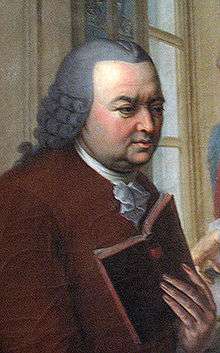Gerard van Swieten
| Gerard van Swieten | |
|---|---|
 | |
| Born |
7 May 1700 Leiden |
| Died |
18 June 1772 (aged 72) Vienna |
| Residence | Austria |
| Nationality | Dutch |
| Fields | Physician |
| Doctoral advisor | Herman Boerhaave |
| Doctoral students |
Nikolaus von Jacquin Anton von Störck |
Gerard van Swieten (7 May 1700 – 18 June 1772) was a Dutch-Austrian physician.
Life and work
Van Swieten was born in Leiden. He was a pupil of Herman Boerhaave and became in 1745 the personal physician of the Austrian Empress Maria Theresa. In this position he implemented a transformation of the Austrian health service and medical university education. He was the proposer of the main sanitary reform in the Habsburg Monarchy, "Generale Normativum in Re Sanitatis", implemented by Maria Theresa in 1770.[1] He founded a botanical garden, a chemical laboratory and introduced clinical instruction. Since 1745 he was also librarian for Maria Theresa in what was then the Imperial Library.[2]
Beside his medical activities, Gerard van Swieten was also active as a reformer. Especially the censorship was organised in a different way under his direction. He drove out the Jesuits that were in charge of the censorship before and carried out a centralisation of the censorship that was only partly successful. He also tried to use scientific and rational aspects for the judgement of literature.
Vampires
Especially important is his part in the fight against superstition during the enlightenment, particularly in the case of the vampires, reported from villages in Serbia in the years between 1718 and 1732.
After the last of the wars against the Turks in 1718, some parts of the land, such as Northern Serbia and a part of Bosnia, went to Austria. The parts were settled with refugees with the special status of duty-free farmers. However, they had to take care of the agricultural development and secure the frontiers so reports about vampires reached, for the first time, German-speaking areas.
In 1755 Gerard van Swieten was sent by Empress Maria Theresa to Moravia to investigate the situation relating to vampires. He viewed the vampire myth as a "barbarism of ignorance" and his aim was to eradicate it.
His report, Abhandlung des Daseyns der Gespenster (or Discourse on the Existence of Ghosts), offered an entirely natural explanation for the belief in vampires. He explained the unusual states in the grades, with possible causes such as the processes of fermentation and lack of oxygen being reasons for preventing decomposition. Characteristic for his opinion is this quotation from the preface to his essay of 1768 "that all the fuss doesn't come from anything else than a vain fear, a superstitious credulity, a dark and eventful imagination, simplicity and ignorance among the people." The report made Maria Theresa issue a decree that banned all traditional defences to vampires being put to the stakes, beheaded and burned.
Family
Gerard van Swieten was the father of Gottfried van Swieten, who had his own career in government service and is remembered as a patron of Haydn, Mozart, and other composers.
Honors
In May 1749 van Swieten was elected a Fellow of the Royal Society.[3] In 1751, he was elected a foreign member of the Royal Swedish Academy of Sciences.
A genus of mahogany was named after Gerard van Swieten, Swietenia, by Nikolaus Joseph von Jacquin.
The Frank – van Swieten Lectures, an international course about strategic information management in hospitals that is organised by TU Braunschweig, University of Amsterdam, University of Heidelberg, UMIT at Hall near Innsbruck and Fachhochschule Heilbronn are named after him.
References
| Wikimedia Commons has media related to Gerard van Swieten. |
- ↑ Sechel, Teodora Daniela. "The Health Care Reforms, the Sanitary Network,and the Physicians (Physici)". The Emergence of the Medical Profession in Transylvania (1770–1848) (PDF). p. 99.
- ↑ Mulder, Willem Johannes Maria (907). Dietrich von Nieheim: zijne opvatting van het concilie en zijne Kroniek. E. van der Vecht. p. iv.
- ↑ "Library and Archive Catalog". Royal Society. Retrieved 24 October 2010.
External links
- Works by Freiherr van Gerard Swieten at Project Gutenberg
- Works by or about Gerard van Swieten at Internet Archive